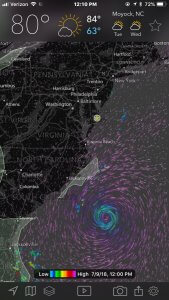For almost 80 years, past and present members of the elite lifeguarding team known as the Ocean City Beach Patrol (OCBP) have dedicated their summers to education, research and saving lives along the ten miles of Ocean City beach. For 46 of those years, Captain Melbourne “Butch” Arbin III has worked for the patrol.
Big Atlantic Storms Cause Rip Currents in Ocean City, Maryland
As we enter hurricane season, storms in the Atlantic can affect our coastline even when we can’t see the storm. Simply put, “When there is tropical activity in the Atlantic Basin, we can get rip currents in Ocean City,” Arbin said. Many may have heard that the ocean during such a storm, whether the storm is seen or unseen, has a higher than average chance of producing rip currents, which are extremely dangerous to swimmers.

Ocean City Beach Patrol Instrumental to the Creation of Rip Current Prediction Models
The National Oceanic and Atmospheric Administration issues these rip current warnings based on models that the Ocean City Beach Patrol helped develop many years ago. A scientist with NOAA was swimming off our coast with his son when they got caught in a rip. The Beach Patrol rescued both swimmers. Shaken, this scientist approached the OCBP and said that a prediction model needed to be developed to help warn swimmers of dangerous conditions. The OCBP began calling in the number of rescues each day and the scientists at NOAA correlated that data with wind speeds and direction, tides, and wave height. When a weather forecast is made with conditions that in the past have resulted in high numbers of rescues from rip currents, then models show that rip currents are likely to accompany those predicted conditions.

NOAA is not the only organization with which the Ocean City Beach Patrol has worked. Researchers at Johns Hopkins, the Maryland Sea Grant Program, and Dr. Rob Brander aka “Dr. Rip,” who has a site called ScienceoftheSurf.com, have all worked with the Ocean City Beach Patrol to understand ocean conditions dangerous to swimmers and to help educate and inform the public. Captain Arbin takes great pride in ensuring that the OC Beach Patrol “does more education than any beach patrol in the world.”
Rip currents can change every day and even many times a day.
What is a Rip Current?
Basically, rip currents are simply large volumes of water trying to get out of constricted areas. When a sand bar is offshore and there is a trough of deeper water between that sand bar and the beach, water gets stuck in the trough. At high tide, the water is deeper over the sand bar and lots of water can wash back over the sand bar so there isn’t as much “trapped” water.
When the tide is really low, much less water pushes over the sand bar into the trough where it gets stuck so, again, the volume of water “trapped” is lower. However, when the tide is falling and lots of water is in the trough but the depth decreases over the sand bar, all that water is still in the trough and is blocked by the sandbar. This water is pulled to the breaks in the sandbar where it can get out of the trough and back out to sea. Rip currents pull swimmers down the beach in the trough until they reach the break in the sandbar and then the current pulls swimmers straight out to sea through that break in the sand bar.
Can Anybody See a Rip Current?
If you are on the beach, you can see breaks in the sandbar where the dangerous rip currents exist. The members of the Beach Patrol can see them better because they are higher off the beach and have a better perspective. What they look for are plumes of sand that go out beyond the breaking waves.
When the waves are big and the ocean looks angry, most swimmers stay on the beach and the Beach Patrol actually see less rescues. It’s when the weather is great, the skies are blue and the waves are clean that more people venture back into the water. A storm may pass, but the conditions could still be excellent for increased rip activity because lots of water is still pushing over the sand bars and into the beach where it gets trapped. It will find its way back out to sea and will take even the best swimmers with it. Rip currents can be so strong that even Michael Phelps can’t swim against them.
Most Rescues are from Rip Currents
My son was a Beach Patrol member for four summers. His first rescue involved two little girls who were pulled down the beach by the rip current and then out through the break in the sandbar off shore. Two other lifeguards were involved in that rescue. Everybody was fine, but the impact on my son forever changed him. He realized that people’s lives actually depended on him, and that if he didn’t perform his job well and if he wasn’t lucky, somebody could actually die.
He rescued one child by diving for her as she went under water. According to Arbin, 95% of all rescues performed by the Ocean City Beach Patrol are of swimmers rescued out of rip currents. Only 2% of drownings in Ocean City over the last 80 years occurred when the Beach Patrol members were in their chairs guarding the swimmers.
“98% of all drownings occurred before or after the Beach Patrol guards were in their stands,” said Arbin. “PLEASE don’t swim if we aren’t there to help you.”
What Should You Do if Caught in a Rip?
If you do get caught in a rip that you can’t swim out of, stay calm. The worst thing to do is panic. If you remember that Michael Phelps can’t swim against some of the worst rips, then you have to keep your head and swim diagonally towards shore.
Remember, the water only rushes to make it back out to open water and then the current dissipates. If a swimmer doesn’t get exhausted fighting the current, they will soon find themselves in calm water. Then he or she can swim back to shore behind the sand bar and out of the rip. If a swimmer swims diagonally across the rip towards shore, they will soon find themselves away from the pull of the current so they can make their way back to the beach.

Stay Informed
The ocean in Ocean City, Maryland is beautiful and powerful. Some days it’s as calm as glass and others it’s wild and fierce. For some, this area is home and for others it’s a long-awaited respite. For all of us, the ocean provides a wonderful place to play and to enjoy nature at its best. Like with all outdoor activities, educate yourself and know the risks.
Check out the Beach Patrol site. Get to know the guards on your beach. They will give updates each day with information and risks in your area. They might also be the people who save your life or help reunite you with a lost child. The Ocean City Beach Patrol technicians are well trained, equipped with first aid kits, lots of information, and the skills to keep you safe on the beach and in the water all summer.
More links:
General Information on the Beach Patrol
History of the Ocean City, Maryland Beach Patrol and of lifesaving
Semaphore Alphabet (Figure out what that guard is saying to the next guard)

